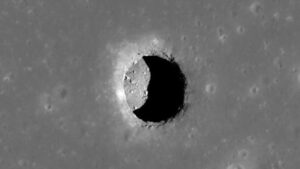As Apollo 17 commander Gene Cernan left the surface of the moon in December 1972, he paused for a moment to deliver a message: “As we leave the moon…we leave as we came, and God willing, we shall return, with peace and hope for all mankind.”
More than half a century on, the late American astronaut remains the last human to set foot on the moon. But it’s not as if global space agencies have rested on their laurels. The ensuing decades ushered in the Space Shuttle program, the Hubble Space Telescope, and the International Space Station.
By comparison, returning to the moon became less of a priority, and public interest in space exploration fizzled out.
The upcoming Artemis missions might change that. Yesterday, NASA announced the four-person crew of the Artemis II mission, the first manned space flight in 50 years to travel beyond low-earth orbit and orbit the moon.
The aim of Artemis is to set foot on the moon again and establish a long-term presence on the lunar surface as a launch pad for future missions to Mars.

The Artemis II Mission Map. Photo: NASA
A controversial vision
Artemis II is scheduled to launch in November 2024 and orbit the moon before returning to Earth. Just over a year later, NASA intends to land an international crew on the lunar surface during the Artemis III mission in December 2025.
Detractors of this new era of space exploration argue that it comes at a time when we have more pressing global challenges. “Space missions often look for signs of life on the moon or Mars, yet we ignore the quantity and quality of life on Earth,” suggests one American professor of popular culture.
Criticism of space exploration is not always overt, though. The Guardian, which is well known for its strong editorial focus on climate change, relegated yesterday’s Artemis II crew announcement to a mere footnote of a regurgitated Reuters article.

The crew of NASA’s Artemis II mission (left to right): NASA astronauts Reid Wiseman, Victor Glover, Christina Hammock Koch, and Canadian Space Agency astronaut Jeremy Hansen. Photo: NASA
Those who criticize human space exploration suggest that investment in space is to the detriment of efforts to improve life on Earth. But is that really the case?
Clearly, blasting hundreds of tons of fuel into the atmosphere to fire a rocket beyond our realms will contribute to carbon emissions. However, in the past two decades, advancements in space technology have vastly improved our comprehension of Earth’s climate. Satellites, for instance, have been instrumental in our understanding of changes to the atmosphere, oceans, and ice caps.

NASA’s uncrewed Orion spacecraft snapped this black-and-white photo of Earth on Nov. 17, 2022, the second day of the Artemis I mission. Photo: NASA
Space inventions have earthbound uses
And then there are the future innovations to come. Investing in space technology and exploration could bring spillover effects for life on Earth. The development of new technologies for space travel and habitation will likely have applications in fields like medicine, energy, and environmental science. The Apollo program led to advances in microelectronics, medical technology, materials science, and energy technology.
Space exploration provides more than just technological innovation. It can also offer hope, wonder, and awe. For those of us who missed the pioneering era of space exploration, our experience with innovation and exploration has been mostly electronic. We haven’t witnessed the collective efforts of hundreds of thousands of skilled workers striving toward a seemingly impossible goal. Nor have we looked up at another celestial body and realized that at that moment, human beings were standing on its surface. What price can you place on inspiration and hope in a world where mainstream media often highlights our failures as a species, rather than our potential for collective achievement?
If we are to tackle the social challenges ahead, we arguably need innovators and pioneers who are willing to push the boundaries of what is possible. What NASA’s head administrator, Bill Nelson, refers to as “pioneers, star sailors, thinkers, and adventurers.”
It’s worth remembering that we developed as a global society in part because we sought out challenges and pushed to innovate and progress. While we must focus most of our attention on the challenges on Earth, allocating even half a percent of our resources to space exploration would not detract from these pressing issues.

Japanese astronaut Koichi Wakata in his Extravehicular Mobility Unit, or spacesuit, during his second spacewalk. Photo: NASA
Not a race among nations
From a social sense, there are benefits too. NASA’s Artemis program aims to land the first woman and first person of color on the moon by 2025. This is important for several reasons. Historically, the space industry has been predominantly white and male. Sending a more diverse crew to the moon conveys a message that everyone can be part of space exploration. It could also inspire a new generation to pursue careers in STEM fields. Most importantly, it helps promote diversity and inclusivity across all parts of society.
In his book Carrying the Fire: An Astronaut’s Journeys, astronaut Michael Collins argued that the early space program was not just about the United States. Rather, it was a human endeavor encompassing all nations. He wrote, “The conquest of space is not a race among nations, but one involving people of all nations in the search for knowledge for the benefit of all.”
Collins believed that space exploration should unite people rather than divide them. And that is what NASA plans to do with Artemis. It will include partnerships with European, Canadian, and Japanese space agencies, among others.

Command Module pilot Michael Collins practices in a simulator at Kennedy Space Center. Photo: NASA
Bored billionaires
Capitalizing on the benefits of space exploration will, of course, require careful management to ensure that the richest nations don’t exploit extra-terrestrial resources, and that bored billionaires don’t toy with space travel without placing the benefit of wider humanity as the guiding principle of their ventures.
It’s easy to criticize the big players like Elon Musk and SpaceX for somewhat outlandish dreams of a multi-planetary existence. Still, it would be foolish not to explore this, in the just-in-case scenario that someday a few have to leave an uninhabitable Earth to ensure the long-term survival of the human species on another planet.
Over 50 years have elapsed since Cernan delivered his stirring words on the lunar surface. We’ve all become accustomed to satellites and telescopes beaming back to us extraordinary images of our solar system and beyond.
Let’s not forget how extraordinary it is that we are able to shoot a crew of fragile humans up beyond the blue, into the troposphere, stratosphere, mesosphere, and into the black of space. Human space flight has the potential to inspire, spark innovation, and break down borders. We need a dose of those three things now more than ever.






